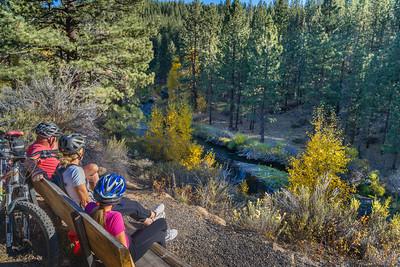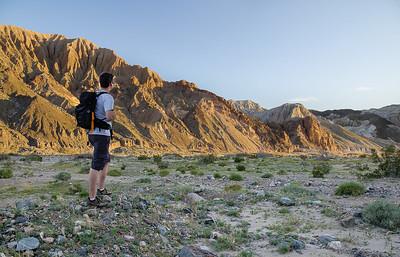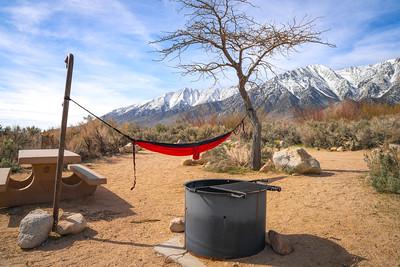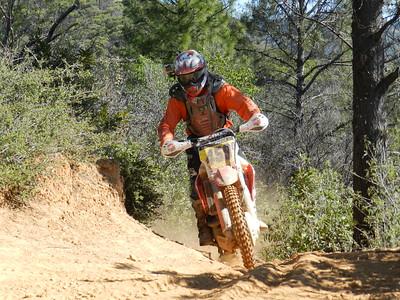Recreate responsibly on public lands this Memorial Day and throughout the Summer

This Memorial Day weekend, we recognize those who sacrificed for our nation, and want to remind visitors to recreate responsibly while enjoying public lands managed by the Bureau of Land Management. Public lands provide open spaces for recreational opportunities, such as fishing, swimming, camping, rockhounding, backpacking, hiking, boating and off-highway vehicle use. Many of these special places are free of charge for the public to enjoy.
Before heading outdoors, know before you go and always Recreate Responsibly.
In California alone, the BLM oversees 15 million acres of public lands that support the agency’s multiple-use mission, which includes 25,000 miles of off-highway vehicle routes, 630 recreation sites and areas, 1,760 miles of designated trails, and 356 miles of rivers for recreation. The BLM also manages about 630 recreation sites statewide.
Here are some additional safety tips to follow when visiting your public lands:
Fire Safety and Use of Fireworks
Possession or use of fireworks is prohibited on all BLM-managed public land in California. This includes the “Safe and Sane” devices commonly sold at fireworks stands. CAL FIRE offers 4th of July Safety Tips.
Fire danger in California increases as temperatures rise and vegetation dries. On average, human-caused wildfires make up 95 percent of all wildfires in California. Many of these wildfires occur close in proximity to roadways, communities, and recreational areas, posing considerable threat to public safety.
Taking individual responsibility to reduce wildfire risk, while recreating on public lands, around homes and communities, before a fire occurs can help keep property, the public, and firefighters safe. Learn about fire restrictions and where campfires are allowed be sure to have a campfire permit from CAL FIRE.
Streams and Rivers, the Pacific Coast

Water-related rescues are common during summer as public lands visitation and recreation rise.
However, this summer season also presents some additional risks; as the temperatures rise streams and rivers in California are running colder, higher, and faster than they have in recent years, due to the melting of heavy mountain snowpack.
The frigid waters can cause a person’s muscles to cramp quickly, affecting their ability to swim and get out of the water. Keep in mind that although the air temperature may be hot, the water temperature below a river’s surface can be much colder and can cause hypothermia quickly. It is advised to learn how to recognize hypothermia and follow all signs that warn of dangerous river conditions or fast-moving currents.
Kayakers and rafters should wear a U.S. Coast Guard-approved personal flotation device and follow California boating laws and regulations. Additional protective items can include a helmet to protect the head from impact injuries and water shoes to protect the feet from floating debris, sharp rocks, or slipping hazards. Watch children and pets closely; keep them away from fast-moving water, be sure they have flotation devices and stay close to them while they are playing in or near the water.
When hiking the Lost Coast Trail in the King Range National Conservation Area, watch out for sneaker waves and never turn your back on the ocean while on the beach. The BLM also advises the public to stay high up on beaches out of the wet sand area. A tide chart is critical for the Lost Coast Trail, as some areas are impassable at high tide. Review this Lost Coast Trail Tide Safety brochure for more information.
The public should also remain cautious when visiting steeply sloped beaches. North Coast beaches are not swimming beaches; the extremely cold water can paralyze your arms and legs within minutes without proper cold-water gear, making it impossible to keep your head above water. Check out this beach safety brochure for more information on how to stay safe on North Coast beaches.
Hiking and Trails

Before trekking on BLM-managed trails, it is best to research the area and plan the visit. Follow the “Leave No Trace” principles to minimize impacts to public lands and wildlife and consider a hike’s abilities and physical condition. Underestimating the difficulty of a trail can lead to disastrous consequences, especially for a beginner hiker. When venturing out on a hike it is always best to tell someone at home where you are going to be and send them GPS coordinates. Never wonder off a designated marked trail and know before you go by checking the land-management agencies website ahead of a trip for closures, alerts, or warnings.
While exploring the California desert or any other hot region, be mindful of extreme temperature changes; it is common to see more injuries and fatalities in the summer due to heat stroke or dehydration since temperatures often soar above 100 degrees Fahrenheit. Be sure to bring more water than you think you’d need and remember to sip often. For information about known safety hazards or public lands closures, contact the local BLM field office, or stop by a visitor center before departure. And, no matter what, never leave children or pets alone in a hot car for any amount of time.
Always dress appropriately for the weather, wear sunscreen, and bring plenty of water to stay hydrated. Check with local weather reports on the day of a hike and continue to check weather reports regularly when backpacking, especially in a slot canyon. Many public land resources, including social media pages, provide flash-flood warnings and adverse weather updates. And finally, keep in mind that campsites or backpacking with food can attract wildlife. As such, secure food and other odorous items such as garbage in a "bear box," or in an approved bear-resistant food canister to attract less interest.
Check with online resources, such as blm.gov/visit and www.recreation.gov, to find more information about a trail’s level of difficulty, closures and hazards, water safety tips, and recreation and shooting restrictions.
Camping and Backpacking

When camping on BLM-managed public lands, never leave a campfire unattended; always carry a shovel and water; and check weather forecasts and possible fire danger restrictions before leaving home. Visit CAL FIRE online to obtain free training in advance on campfire safety, get a burn permit, or a campfire permit.
Always be aware of the wildlife in the area, especially when backpacking overnight in an area where bears or other predators are known to inhabit. Backpackers and campers should bring a bear canister to store food, which is the simplest and most effective way to prevent bears or other wildlife from being attracted to a camp and accessing food. It is also a good practice to bring a GPS handheld satellite communicator or a smartphone to use in case of an emergency in the backcountry, navigation devices and maps, first aid supplies and light sources.
Hunting and Recreational Shooting
Before heading out to hunt on BLM-managed public lands, take a hunter safety training course and follow the required safety measures for hunting and recreational shooting. Also, check weather conditions and red flag warnings; avoid shooting in hot, dry, and windy weather; and follow local guidance relating to shooting and fire restrictions. Fire weather forecasts are available through the National Weather Service. Hunting and fishing are regulated by the California Department of Fish and Wildlife. The BLM recommends obtaining a current map and directions to open hunting or target shooting areas.
Upon arrival, be aware of dry vegetation, and dead trees, and avoid driving or parking vehicles in tall grass. Park and camp away from dead trees and branches that can blow down and fall. Use appropriate trailer pins and hitches to keep the chains from dragging and creating sparks. Remember, one less spark means one less wildfire. Finally, be mindful to avoid shooting on or across roads, waterways, or trails.
Off-Highway Vehicles

Public lands provide great opportunities for all-terrain and utility-task vehicles, including dirt bikes, side-by-sides, and four-wheelers. Vehicle safety should always be everyone’s top priority. Planning should include leaving a trip itinerary behind with a friend or family member. The itinerary should include the trip location and expected return time.
Also, be sure off-road vehicles are registered and in good operating condition. Make sure tires are in good shape and suitable for the terrain being encountered. If riding a motorcycle, ATV or UTV, wear a helmet and protective clothing, stay on designated routes and trails, and make sure the spark arrester (if required for the type of vehicle) is in good working order. Keep in mind it is illegal to exceed a speed limit or operate a vehicle recklessly within 50 feet of a camp/large groups of people, where the speed limit is 15 mph.
For more information on how to obtain an “America the Beautiful – National Parks and Federal Recreational Lands Pass” for access to federal lands and waters across the country, visit the BLM’s Recreation Passes Web page. There is now a lifetime pass available for military veterans and Gold Star families to access public lands. Have a safe and enjoyable summer!
Additional Resources:
- NOAA Watches, Warnings or Advisories for California
- NOAA Tide Prediction
- Reserve a campground
- U.S. Forest Service alerts
- Recreate Responsibly, Water Safety
- NIFC Wildfire information
- Tread Lightly principles
Sarah Denos, Public Affairs Specialist
Related Stories
- State summits collect valuable input for implementing BLM’s Recreation Blueprint
- BLM educates families on benefits of the Access Pass
- Eagle Scout service project enhances BLM's Fowl River Access Site
- Service dogs doing their jobs on public lands
- Neil Hamada steps into new role as Off-Highway Vehicle Travel Management Lead for BLM California
